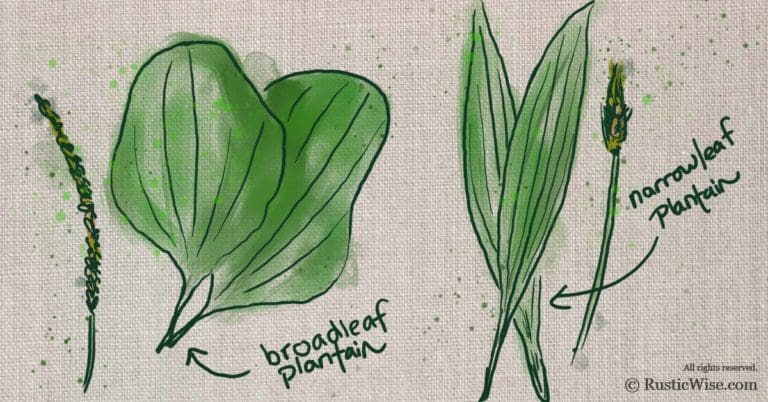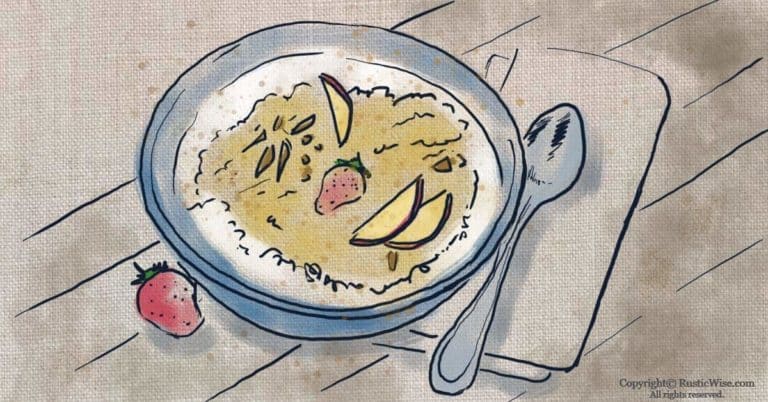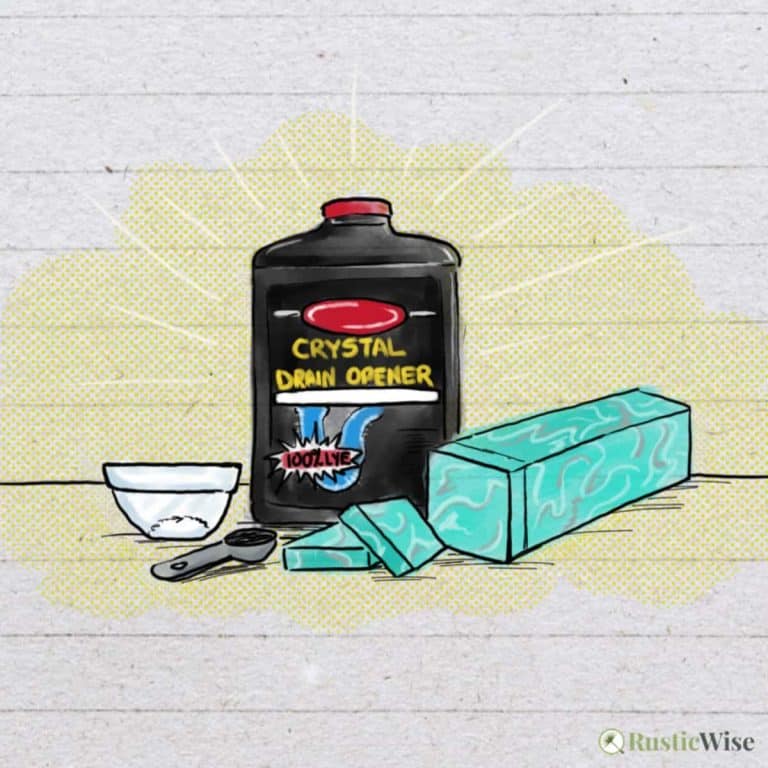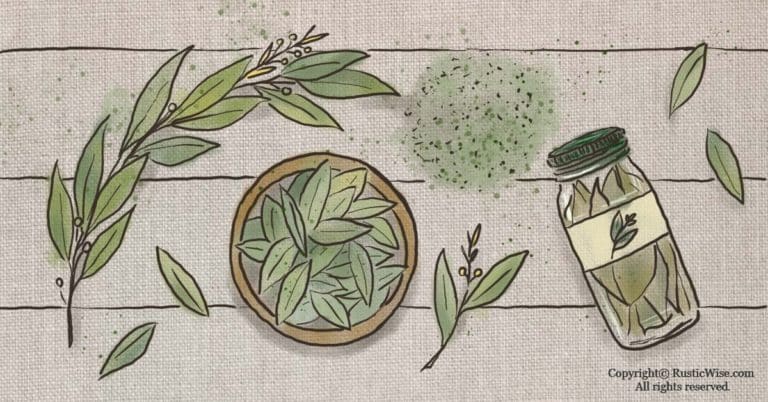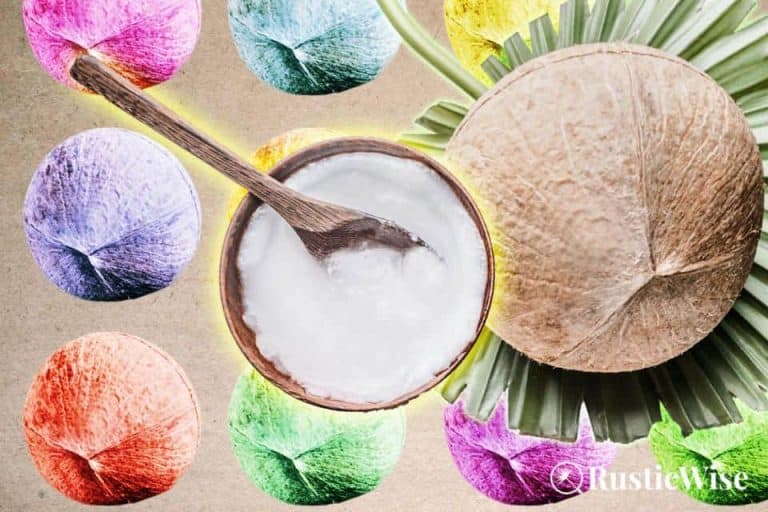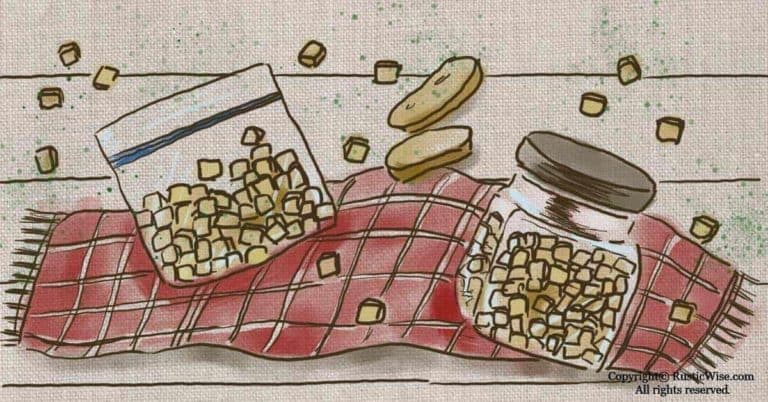Broadleaf Plantain Uses: An Edible Wild Food with Healing Properties
RusticWise is supported by its readers. When you purchase through links on our site, we may earn an affiliate commission. As an Amazon Associate, we earn from qualifying purchases. Thank You!
This so-called weed is the epitome of resilience. You’ll see them poking between the cracks of sidewalks, along fences, and pretty much anywhere where humans have disturbed the land.
We’re talking about the broadleaf plantain (Plantago major), also known as greater plantain, or common plantain (not to be confused with plantain fruit which is similar to a banana!).
While many people view this plant as a nuisance or weed, it’s time to shed some light on the many broadleaf plantain uses including its nutritional and healing properties. Rich in vitamins A, C, and E, Plantago major is a nutritious edible wild food that can be harvested for its leaves, seeds, and roots. It’s also used for many medicinal purposes, including healing skin irritations and minor wounds.
What does a broadleaf plantain look like?
As the name implies, the broadleaf plantain has wide, thick, spade-shaped leaves. Plantain leaves have five to nine veins running lengthwise. You’ll be able to identify them easily by its clustered small, green-brown flowers with a purplish stamen.¹
You can find this common garden plantain weed throughout North America, most of Europe, and in parts of central to north Asia.²
On average, the broadleaf plantain is 15-30 cm (6-12 inches) in diameter. In some cases, the flower stalks can reach heights of 25 cm (10 inches).¹
This perennial plant pops up in the same places year after year. It’s frequently found along sidewalks, roads, and lawns. It thrives in environments where humans have caused a “disturbance.”
Note: There’s another similar plant known as narrowleaf plantain (Plantago lanceolata), or ribwort plantain. As the name suggests, the narrowleaf cousin has slimmer leaves and is not as widely found as common plantain. Narrowleaf varieties are also edible and have similar properties.
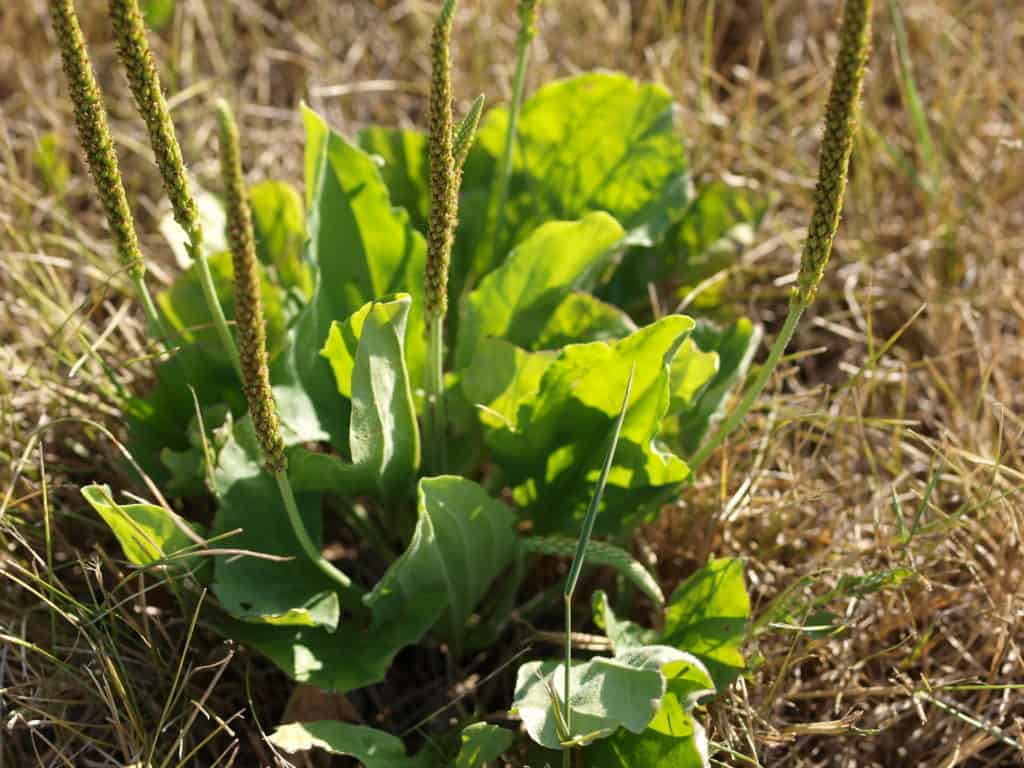
Credit: F.D. Richards / Flickr, Broadleaf Plantain
History of broadleaf plantain
The broadleaf plantain has a long roots reaching back to Europe from pre-Columbus times (essentially any time period before 1492). Many Indigenous people refer to the broadleaf plantain as “the white man’s footprint” as it seemed to appear wherever European settlements sprang up.³
Healing properties of broadleaf plantain
The medicinal properties of plantain have long been known. Broadleaf plantain is used fresh, dried, or in powdered form, depending on the purpose.
References of plantain use for healing even appear in popular works of art such as Shakespeare’s Romeo and Juliet. In Act 1, Scene 2 Romeo references the plantain leaf:
ROMEO: Your plantain leaf is excellent for that.
BENVOLIO: For what, I pray thee?
ROMEO: For your broken shin.
Romeo & Juliet
While Romeo might have been a bit confused (plantain leaves clearly can’t heal broken bones!), it speaks to the practice of using the healing properties of this well-known plant.
The broadleaf plantain has many medicinal properties.
It’s antibacterial, acts as an astringent (tones and tightens), and acts as a diuretic (the seeds have laxative properties). It also helps to stop bleeding, reduce fever, soothes skin ailments, and helps neutralize poisoning.
Plantain leaves act as nature’s cleanser to protect the body from infectious diseases from contamination or unsanitary situations.
Here’s just a few ways you can use this medicinal her heal and nourish:
- Treat minor wounds: Have an insect bite? Make poultices of plantain leaves to treat insect bites, small cuts, minor burns, and other minor skin irritations. You can chew up plantain leaves into a mash and apply to wound. If you don’t have a bandage with you, try wrapping another plantain leaf around the poultice to secure it in place. This is handy when you’re out enjoying nature and don’t have access to other medicines.²
- Soothe and heal: Use fresh leaves or powdered plantain as a natural way to treat minor snake bites, and encounters with poison ivy or stinging nettle. Or make a plantain salve to carry with you on your outdoor adventures.
- Foot soak: Place fresh or dried plantain in hot water for a foot soak after a long day.
- Natural astringment or mouthwash: Make a plantain herb tea for washing and toning your face. The plantain tea when mixed with some ground-up root can be used as a mouthwash.
- Tea for healing: Brew plantain leaf tea and let it cool. Apply the cooled tea to soothe minor cuts or skin ailments. Or, sweeten the tea with a bit of honey, and enjoy a soothing cup of herbal tea.
- Natural laxative: Use Plantain seeds as a laxative (another option if you don’t like the taste of prune juice!).
Is broadleaf plantain edible?
The whole broadleaf plantain is edible from seed, to leaf to roots, except for the stem. The stem is too fibrous and tough for most people to eat.
Cautions when using Plantago major
As with any wild edible food, use caution before using or ingesting. As this herb is very fibrous, it’s NOT recommended for those with intestinal obstruction, or stomachaches. Consuming large quantities of Plantago major may cause a drop in blood pressure. Some people may experience contact dermatitis.
Please consult with a doctor or medical professional for using.
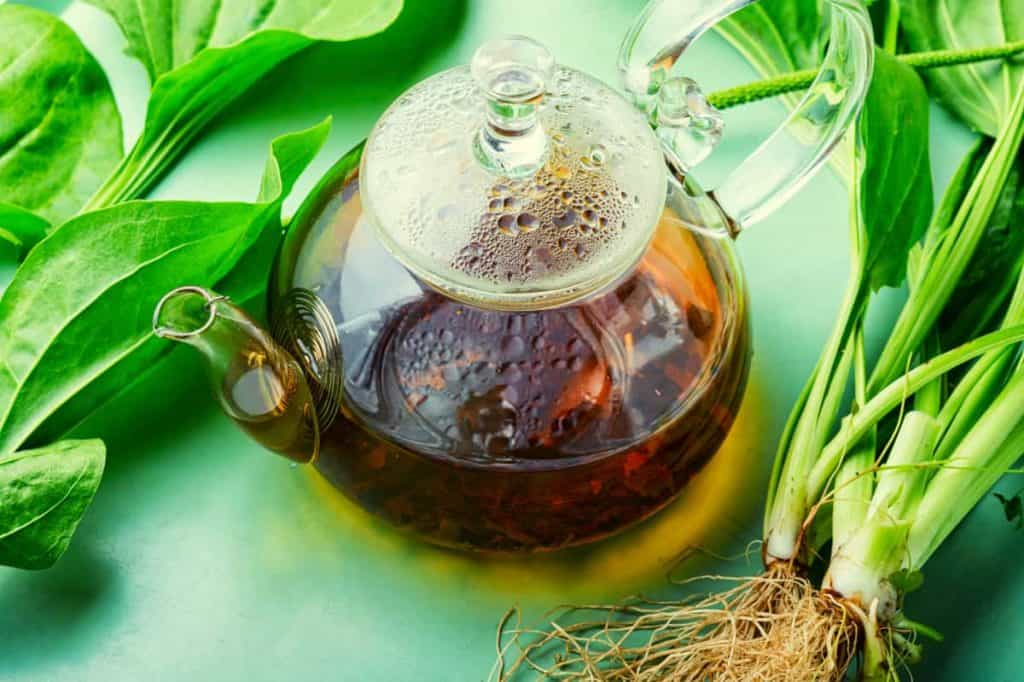
How to use broadleaf plantain in the kitchen
Of the many edible wild foods out there, Plantago major isn’t exactly the tastiest of the bunch.
So, what exactly does plantain leaf taste like? Some would describe it as an earthy, nutty, slightly bitter taste with peppery notes.
But there are ways to get around the strong flavor, and reap the nutritional benefits of this broadleaf herb.
Note: The soil and growing conditions of plantain can greatly affect its taste. If you’re foraging for this herb and encounter a particularly bitter batch, you might have better luck elsewhere!
Plantain leaves
The larger leaves have a full-bodied, robust and slightly bitter flavor with a fibrous texture. It may be a bit of an acquired taste.
Small, young leaves are more palatable and tender with a taste similar to asparagus.
If you find the leaves too chewy and fibrous to your liking, try blanching them for a minute or two to soften before adding to your dishes.
Dice up those plantain leaves before adding them to your favorite dishes:
- Add to fresh salads.
- Lightly cook and add to stir-frys.
- Blend into green smoothies or shakes.
- Throw a handful of leaves into your vegetable stock.
Plantain seeds
You can try eating plantain seeds on their own, sprinkled over salads, added to recipes such as porridge, soup or bread, and ground finely into powder. The seeds are rich in vitamin B1.²
Some say that ingesting the seeds may act as a natural insect repellent.⁴
Brown seeds are mucilaginous. When soaked in water, they turn gelatinous (similar to chia seeds) and are used to thicken foods.
Plantain seeds can be green or brown, depending on the age of the plant (newer plants have green seeds, older ones have brown seeds).
Tip: To eat the plantain seeds alone, place a shoot between your teeth and pull to extract the seeds.
Plantain roots
While the roots are not very big, try adding them to soups, stews, and cooked vegetable dishes.
Nutritional content of broadleaf plantain
If more people knew the nutritional benefits of broadleaf plantain, we would grow gardens full of them rather than treat them like an invasive weed. You’ll want to find more broadleaf plantain uses in the kitchen to stock up on your daily dose of vitamins.
Broadleaf plantain has a similar nutritional profile to dandelion. It’s chock-full of iron. The leaves contain vitamins A, C, E along with magnesium and calcium.⁴ This helps with building/maintaining/repairing bones, teeth, organs, and muscles.
Plantain is also a rich source of potassium—good for the heart and organs.
Broadleaf plantain recipes
The following recipes are adapted from the book The Wild Wisdom of Weeds: 13 Essential Plants for Human Survival by Katrina Blair. It’s a great book if you want to learn more about the edible and medicinal weeds growing in your own backyard.
Plantain Breakfast Porridge
- 2 cups water
- ½ cup finely ground plantain seeds
- 1 cup oats
- ½ cup raisins, soaked
- 1 tsp cinnamon
- 1 banana
Bring water to boil. Turn off heat. Add the plantain seeds and oats to the water and stir periodically. Add in raisins and cinnamon. Before serving, slice in the banana and feast on the marvelous healing properties of the wild plantain.
Plantain Juice
You can make this fresh green juice to drink, or as a healing wash on skin.
- 1 cup plantain leaves
- 3 cups water
- 1 apple (optional)–Since plantain leaves are slightly bitter, the apple adds some much needed sweetness as a nice counterbalance if you’ll be drinking this.
Blend together and strain out the pulp. Use the juice as fresh as possible. Use this juice can as a healing wash or as a nutritious daily juice.
Plantain Raisin Pecan Salad
- 1 head of cauliflower, diced
- ½ cup of chives, diced
- 2 cups plantain leaves, diced
- 1 cup pecans
- ½ cup raisins, soaked
DRESSING:
- 1 lemon, juiced
- 1 tsp salt
- 1 cup raisin soak water
- 2 tbsp honey
- ½ avocado
Dice the cauliflower, chives, and plantain together and place in a bowl. Add the pecans and raisins. Blend all the ingredients of the dressing together and drizzle over the salad. Enjoy!
Foraging safety tips
While you can buy dried plantain online, you may wish to forage your own food source.
As with any wild foraged plant, be mindful of the environment the plant is growing in. Particularly with broadleaf plantains that love to sprout up in the middle of the city, use your intuition and commonsense to see if it’s a good place to harvest the plant.
Many areas in the city use herbicides and pesticides to keep weeds at bay. You’ll be able to spot sprayed weeds by their wilted appearance. Others might have discolored spots.
Tip: Don’t confuse plantains with members of the Lily family, which can be poisonous. Their leaves look similar. If unsure, wait until flowers sprout to tell them apart.
Related questions
Can you eat broadleaf plantain raw?
Yes, you can eat the fresh leaves raw. If you plan to eat uncooked leaves, choose younger leaves which are more tender and have a less bitter flavor. Many prefer to cut and cook plantain leaves before eating.
Can you dry plantain leaves to be used later?
Yes, absolutely. The leaves can be harvested, dried, and stored in an air-tight container away from direct light and heat. You can also ground the leaves into a fine powder.
Can chickens eat broadleaf plantain?
Yes, this common weed is safe for your backyard poultry. Chances are, you may have a few (or a lot) of plantain growing in your yard. Luckily, this naturalized weed is edible for chickens, and may actually provide some protection against harmful bacterial infections. Plus, it’s packed with vitamins!
👉 If you like this post, see our Timeless Guide To Foraging for Wild Food. 🌿
Would you like more timeless tips via email?
Fun tips to help you live an independent, self-sustaining lifestyle. Opt-out at any time.


References
- Blair, Katrina (2014). The Wild Wisdom of Weeds: 13 Essential Plants for Human Survival. Chelsea Green Publishing. ISBN 978-1-60358-516-3.
- Plants For A Future, Plantago major – L., https://pfaf.org/user/plant.aspx?LatinName=Plantago+major. Accessed September 2022.
- Live Science, The Five Healthiest Backyard Weeds. https://www.livescience.com/15322-healthiest-backyard-weeds.html. Accessed September 2022.
- Canadian Wildlife Federation, Broadleaf Plantain (Plantago major). https://cwf-fcf.org/en/explore/gardening-for-wildlife/plants/edibles/edible-wild-and-not-so-wild-plants/plantain.html. Accessed September 2022.

Author: Theresa Tesolin
Theresa is co-founder of RusticWise. She helps people unleash their inner DIY spirit by encouraging them to get dirty and make or grow something from scratch.


